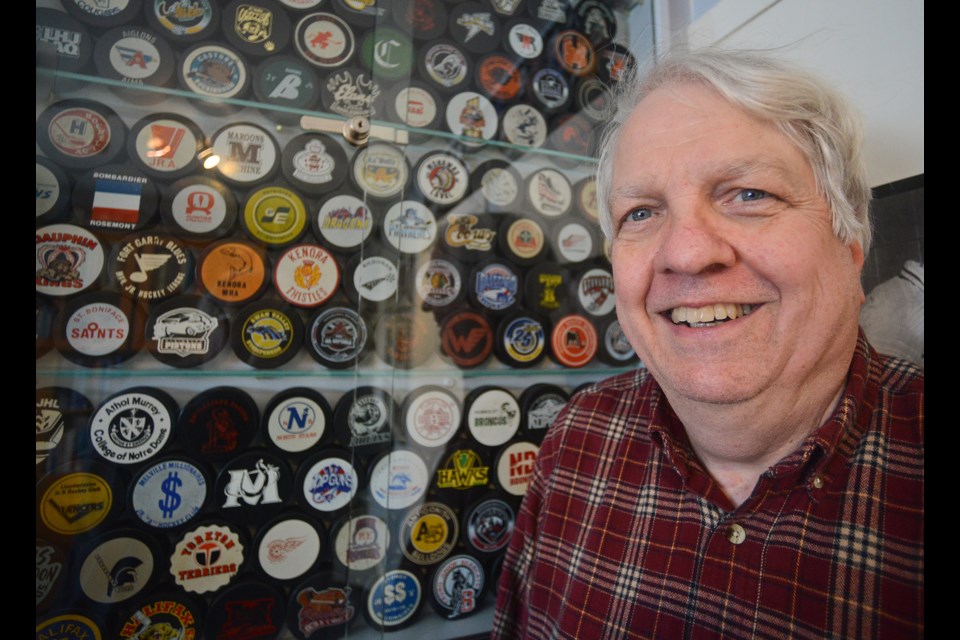Blame Ron Ryan.
It was Christmas of 1956 when Ryan, an 18-year-old forward playing for the Guelph Biltmores, gave a young David Kendrick a crested hockey puck as a Christmas gift. Ryan billeted at the Kendrick’s home and the puck was a token of his appreciation.
Little did he know what he started.
Sixty two years later, Kendrick now sports one of the largest and most extensive hockey puck collections in the world: almost 2,700 pieces of three-inch vulcanized rubber emblazoned with logos of teams from obscure junior D teams in towns you've never heard of up through National Hockey League and everything in between.
They include leagues that no longer exist and teams that barely even did.
For all the glitz and glamour of the NHL pucks, or the eyebrow-raising complete set of pucks depicting the headshots of the 1972 Team Canada team (a Bacardi promotion at the time), it’s the ones from small towns across the continent that Kendrick likes the most.
“Little tiny towns that have hockey teams, to me that’s more fun than the Montreal Canadiens,” he said of his collection. “The fun stuff is Wiarton, Plattsville and Arthur.”
An upstairs room shows off 900 of the collection at a time. The rest stored in the basement. They occasionally get rotated.
“I like to display them so everyone that comes in can see one from their home town,” says Kendrick, a lifelong Guelph resident, former city councillor and one of the members of the original group that brought the Guelph Storm to the city in 1991.
Kendrick, whose dad collected coins and whose mom collected stamps, keeps a detailed data base not only of every puck he has and how much he paid, but also of who he was bidding against. Gotta' keep track of the competition.
From Tilbury to Tulsa, from St. Bonaface to St. Louis, Kendrick has them all. Well, almost all.
“You’ve always got a want list of what you’re looking for,” said Kendrick, who lists a couple of pucks from the long-gone Central Hockey League and International Hockey League as ones he’s hunted for for years.
“I’ve never seen them,” he said with a sigh, wondering out loud if they even exist anymore.
Back in the 1950s and 1960s the only way you got a game puck was if you knew a referee or if one came over the glass, Kendrick said.
It wasn’t until the World Hockey Association came along in the 1970s, and technology along with it, that pucks started sporting creative colourful graphics that were sold at games as souvenirs.
He finds the pucks these days mostly on the internet and at trade shows.
That first 1956 Guelph Biltmores puck is his prize possession, for both sentimental reasons and because it was around that times that puck makers started screen printing team crests onto pucks.
“I will not sell that puck,” said Kendrick, who in his later years is looking to divest himself of some of his collection, mostly to other hard-core collectors on eBay.
Another he is fond of is a puck from the Plattsville Combines intermediate B team, a town where his uncle worked during the week and was the town barber on Saturdays.
He has high standards: no autographed pucks, they have to be readable and game pucks - but not used in a game.
“If it’s autographed you have to have a picture of yourself getting the autograph (to prove it’s authentic),” he explained.
“It’s common knowledge that in the 1970s the Boston Bruins had several people in their front office, each one responsible for autographing pucks for a particular player.”
He makes the odd exception. A favourite for personal reasons is a puck signed by Rocket Richard, Jean Beliveau and Guy Lafleur. The Rocket was his favourite player.
Dispersing oneself of such a huge collection takes time.
He was talking to a collector in the United States recently.
“He said to me, ‘David, the problem you’re going to face is that you don’t know another David Kendrick'.”
